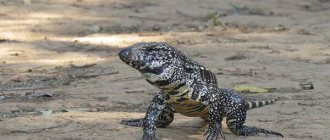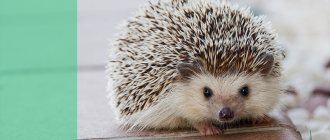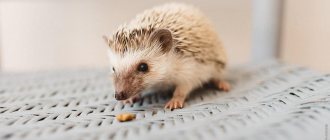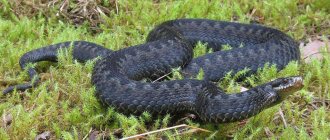Species: Common hedgehog (Erinaceus europaeus)
Order: Insectivores (Eulipotyphla)
Family: Hedgehogs (Erinaceidae)
Genus: Eurasian hedgehogs (Erinaceus)
The common hedgehog, or European hedgehog, is the largest representative of the insectivorous order. It is easy to distinguish it from other animals by its spiny back. This inquisitive and energetic animal is well oriented in the surrounding world thanks to its keen sense of smell and keen hearing. Paleontological studies have proven that hedgehogs have existed in nature for 15 million years.
Appearance of a hedgehog
The common hedgehog is a prickly small animal. The body length of the animal reaches 20-30 centimeters, the tail is short and grows up to 3 centimeters. Adults weigh about 800 grams. Males are slightly larger in size than females.
Instead of hair, the upper part of the body of hedgehogs is covered with a strong, needle-like shell. The head and belly are protected by coarse, fairly tough fur. The needles of European hedgehogs are short, 2-3 centimeters long. The surface of the spines is smooth, thin but long, very sparse hair grows between them.
The muzzle of this species is elongated with a movable and constantly moist nose. On the lower jaw, insectivorous animals have 16 small but sharp teeth, on the upper jaw - 20. The upper incisors are spaced widely so that there is room for the lower one to bite. The first incisors are enlarged and therefore look like fangs. Sharp teeth allow hedgehogs to easily chew shellfish turtles and hard insect wings.
Small ears (up to 3.5 centimeters long) are visible on the wedge-shaped head of mammals. It is noteworthy that the common hedgehogs that inhabit Cyprus have larger ears. In the middle of the head there is a strip of bare skin without needles or hair.
Hedgehog in autumn leaves
The hind limbs of spiny animals are slightly longer than the front ones. The paws have 5 toes with sharp claws. The average size of forelimb prints is 25-30 millimeters, hind paw prints are approximately 35-47 millimeters. The width of the track is about 7 centimeters; the hind limbs partially overlap the prints of the front ones, since hedgehogs move in small steps.
Interesting fact
The body of adult hedgehogs is covered with approximately 5000-6000 strong spines; young hedgehogs have slightly fewer spines - about 3000. Inside the needles are hollow, filled with air.
The color of the fur on the face, legs and belly of common hedgehogs varies from yellowish-white to dark brown. The needles are distinguished by a brownish tint and have characteristic dark transverse stripes. On the chest and throat the color is uniform, without spots. European hedgehogs living in Spain have pale fur color.
Interesting fact
Hedgehogs have well-developed subcutaneous muscles. Strong longitudinal and developed circular muscles of the body help animals curl into a tight, prickly ball, bristling with needles.
Habitat of hedgehogs
The distribution range of the common hedgehog includes Central and Western Europe, Asia Minor, the southern part of Scandinavia and the British Isles, and the northeastern part of China. This species is also found in Western Siberia, in the European part of Russia and the South Caucasus, and in Kazakhstan. In addition, the European hedgehog has been introduced to New Zealand. In the Alps, hedgehogs live at altitudes of up to 2000 meters above sea level in the zone of dwarf pines.
The species Erinaceus europaeus lives in a variety of places in the wild. These mammals prefer to settle in small clearings, in broad-leaved and mixed forests, copses and edges, near river valleys. Hedgehogs often live near people and are found in cultivated landscapes and even in cities. Hedgehogs try to avoid dense coniferous areas and heavily swampy areas.
On the European continent, the common hedgehog can be found in open forests, bushes, grassy plains, sandy areas and even park areas. These animals dig small burrows in bushes and under tree roots, and sometimes settle in abandoned rodent dwellings. Hedgehogs do not stray far from their homes.
Hedgehog in his hole
Common hedgehog - a familiar image
The image of the prickly inhabitant of forests and steppes is well known to everyone. From children's books, the idea of a simple-minded and harmless animal, which is often encountered near forest borders and steppe roads, persists. The origin of the name of the common hedgehog has Latin roots and is translated as “thorny barrier.”
Hedgehog diet
The European hedgehog is an omnivore. The main part of its diet consists of insects, slugs and caterpillars, and earthworms. Hedgehogs also feed on sweet berries and fruits, and seeds of cereal plants. Sometimes they eat mushrooms, acorns and moss, and they can also eat food waste found in summer cottages.
In natural habitats, these mammals rarely attack vertebrates; torpored amphibians and reptiles become victims of hedgehogs. Northern populations of representatives of the hedgehog family feed on frogs, lizards, mice and other small rodents (shrews, voles). They love to feast on the eggs and young chicks of ground-nesting birds. In general, hedgehogs are very voracious and in one night of hunting can eat an amount of food equal to 1/3 of their own weight.
Interesting fact
From time to time, hedgehogs eat both vipers and blister beetles. Their body is characterized by low susceptibility to highly toxic poisons. Studies have shown that hedgehogs are weakly affected by arsenic, opium, sublimate and even hydrocyanic acid. Scientists were able to find out that in large doses, toxic substances are destructive to these mammals, but doses that kill other animals and are fatal even to humans do not harm hedgehogs.
Hedgehog lifestyle
The spiny animals lead a solitary nocturnal lifestyle, but settle close to each other. They go out in search of food after sunset and only return to their shelters in the morning. During the night they can walk up to 3 kilometers, but usually they try not to go far from their home. These animals are especially active in cloudy weather.
During the daytime, hedgehogs sleep, curled up into a loose ball in the main nest or other comfortable shelter places covered with grass and dry leaves. They make homes for themselves in bushes, under tree roots, in caves and abandoned rodent burrows. Their nests, about 20 centimeters in diameter, are lined inside with dry leaves, grass, and moss. It is noteworthy that in the summer, European hedgehogs do not specifically build shelters, but prefer to rest in any place where they feel safe.
The area of individual territories of females covers 5-10 hectares, the territory of males occupies from 7 to 35 hectares. Adult male hedgehogs jealously protect their areas and can show aggression towards their relatives.
Interesting fact (even more interesting facts about hedgehogs)
While studying the behavior of European hedgehogs in New Zealand, scientists noticed that in new living conditions the animals become less asocial and can even spend the night in common shelters. The diet also changed; hedgehogs began to eat native plants, sometimes replacing their usual food of animal origin with them.
Ordinary hedgehogs have well-developed hearing and sense of smell, but weak vision. It is the subtle sense of smell that helps animals find food in complete darkness. In addition, these animals swim well and can jump. When running, they reach speeds of up to 4 kilometers per hour, and walk by stepping on the ground with their entire foot.
Interesting fact
Hedgehogs are sensitive to odors. When encountering a strong-smelling object, they exhibit a very strange behavior that zoologists call “self-lubrication.” Mammals lick the object until foamy saliva begins to secrete in their mouths, and then transfer it to their spines. Scientists have not yet found an explanation for this.
In mid-autumn, when the soil begins to freeze and the amount of hedgehogs’ main food decreases sharply, the prickly animals begin to prepare for hibernation. For the winter, they build large nests in empty spaces under old stumps and tree roots, under piles of dead wood. With the onset of severe frosts, animals hide in a shelter and tightly close the entrance. Then they burrow into fallen leaves, curl into a loose ball and fall into real winter hibernation. And only in a warm, snowless winter can you meet a hedgehog awakened from sleep, wandering around the hole in confusion.
Interesting fact
Hedgehogs use their needle-like cover to transport various “building” materials when constructing a nest for hibernation.
During deep sleep, hedgehogs' heartbeat slows down to several beats per minute, blood pressure drops and body temperature drops sharply to 2 degrees Celsius. During hibernation, the mass of mammals decreases by a third, since they do not feed, but live thanks to the fat reserves stored in the body. If hedgehogs have not accumulated enough body fat (approximately 500 grams) over the summer and autumn months, they may die of starvation in winter.
After a period of hibernation, the animals do not leave the hole until the air warms up to 15 degrees Celsius. At the end of winter sleep, hedgehogs wake up very hungry and can go in search of food not only at night, but also during the day.
Typically, European hedgehogs shed in spring or autumn. This process is slow; only one needle out of three changes per year. Each new thorn takes approximately 12-18 months to grow.
Interesting Facts
Hedgehogs, like other inhabitants of the animal world, are simply amazing creatures. Their behavior and way of life has its own interesting characteristics, and the ingenuity of individual representatives of the species is simply amazing in its originality.
The “use” of hedgehogs and their abilities by humans also looks quite unusual.
Interesting Facts:
- In ancient Rome, Egyptian hedgehogs were used to comb sheep.
- There is a widespread misconception that hedgehogs can carry fruit by pinching it on its spines. This incorrect statement began with an erroneous description of the ancient Roman scientist Pliny the Elder, and then became entrenched through cartoons and fairy tales. Hedgehogs cannot carry weights on thorns, since their structure does not allow them to prick and hold objects weighing more than 50 g.
- In some countries, the heart of a hedgehog is considered an effective talisman against all diseases.
- Hedgehogs can carry leaves and grass on their thorns. The animals roll around in the fallen leaves, and then, when they come to the burrow, they drop their needles. From the brought material they build a cozy nest for the winter.
- Gypsies enjoy eating hedgehogs; fried animals are a favorite dish of nomadic tribes.
- The hedgehog does not store food for the winter, but eats fat. A thin hedgehog will not survive hibernation and will die in its sleep.
- There are traditional methods of treating alcoholism using hedgehog urine.
- At the beginning of the 20th century, the famous fast food restaurant chain McDonalds caused the death of hundreds of hedgehogs. The cups in which ice cream was sold attracted little sweet tooths. But the diameter of the neck did not allow the animals to pull their heads back. Hundreds of hedgehogs died, becoming hostages of inconvenient containers. A year after the mass death of small animals, animal activists achieved changes in the shape of the glasses.
- For centuries, people have domesticated wild hedgehogs and used them to protect homes from rats, mice and snakes.
Reproduction of hedgehogs
Immediately after hibernation, in early spring, the mating season of ordinary hedgehogs begins. Fierce fights often occur between males for the female. Hedgehogs push and bite each other, use their prickly needles in battle, while the animals sniffle very loudly and even snort. However, despite the fierceness of the fight, the males do not cause serious damage to each other. Usually the weaker opponent will simply run away. After the fight is over, the winning male begins courtship - circling around the female, puffing and quietly snorting. These games can last for several hours. As a result, the female strongly smoothes her needles and the pair begins to mate.
Pregnancy in females lasts approximately 5-6 weeks. To give birth to cubs, the expectant mother specially arranges a brood nest, lining it with soft grass and dry leaves. In one litter, from May to October, from 2 to 9 babies are born, usually 5-6.
Interesting fact
If a den with small hedgehogs is discovered by a person or an animal, the caring mother carries the offspring in her teeth to a new nest.
Hedgehogs are born naked, blind and helpless. Their skin has a bright pink hue. Newborns weigh about 20 grams with a body length of up to 6.5 centimeters. Within a few hours after birth, hedgehogs grow light, soft needles (100-150 pieces). Over the next 36 hours, dark-colored needles appear. By this time, the babies are already beginning to see the light and, in general, are growing very quickly.
In the first days of the cubs' life, the mother warms them with her warmth. After a week, small hedgehogs begin to crawl, and at the age of 11 days they can already curl into a ball. Closer to the third week of life, the needle-like cover is completely formed in animals. The lactation period lasts 1 month, after which the young begin an independent life. After two months, the young individuals grow to the size of adults. Hedgehogs reach sexual maturity in the second year of life.
In the wild, the common hedgehog lives 3-5 years, in captivity - up to 10 years.
The hedgehog is having lunch
How to care?
Before getting a hedgehog, you need to weigh all the pros and cons. How to care for your pet? It is necessary to equip a cage measuring 60*90 cm.
A cage of 40*40 cm is suitable for dwarf hedgehogs. For walking, a separate enclosure is provided, better of a natural nature. “Cat litter” is used as bedding.
The animal needs to install a house that matches the size of the individual. Pets love to run in a wheel, ride down a slide, and climb in labyrinths.
The cage is equipped with a tray where the animals go to the toilet. It is recommended to clean it daily.
It is necessary to take into account that domestic and wild hedgehogs shed 2 times a year. At this time, it requires special care. Each time they shed up to 20% of the needles.
The shell is quickly restored. During the molting period, animals are kept only in cages. Otherwise, needles will be scattered throughout the room.
For food, bowls are installed, which are washed every time after the hedgehog has eaten. A drinking bowl is installed for drinking water. Bloodworms, earthworms, and zoobass are used as food.
You can enter meat, chicken or beef. It is not recommended to give pork. It can cause obesity. Hedgehogs are given vegetables, fruits and berries.
They usually refuse acidic foods. They are given sweets with restrictions so as not to provoke diabetes.
On forums they often discuss how to tame animals. Hedgehogs are difficult to train. They do not recognize the owner. They see humans as a source of food.
Animals are smart and adjust their behavior depending on the personalities of their household members. They behave aggressively with some, favor others, and can allow themselves to be picked up and stroked.
Source
Benefits and harms for humans
The common hedgehog eats harmful insects: chafer beetles, gypsy moths, nun caterpillars and weevils, which is beneficial to humans. But at the same time, hedgehogs destroy domestic eggs and chicks, as well as birds nesting on the ground, and eat shrews and moles.
In addition, fleas and ticks are found in large quantities on hedgehogs, and therefore these animals can be carriers of dangerous diseases such as tularemia, tick-borne encephalitis, yellow fever, salmonellosis and leptospirosis, ringworm, and rabies.
In forest plantations and forested areas, hedgehogs collect various ticks (including encephalitis) on themselves much more than any other animals. This is facilitated by the needle-like cover, which, like a brush, collects hungry ticks from the grass. Hedgehogs can no longer get rid of ticks that are firmly caught between the thorns.
What you need to know about keeping hedgehogs at home
Content
Hedgehogs are increasingly used as pets. These cute and funny animals come from the wild, and therefore their content has its own nuances. For example, some species hibernate due to low indoor temperatures and may not wake up.
Let's find out how to care for a hedgehog so that it pleases your household for a long time.
Enemies of hedgehogs in their natural habitat
The prickly animals move through the forest very noisily, and during meals they sniff and chomp, which often attracts attention to themselves. But most predators are too tough for hedgehogs. When meeting large forest inhabitants, sensing the slightest danger, they snort and try to jump up to prick the enemy. If this technique does not work, the hedgehogs curl up into a prickly ball. Mammals can remain in this position for quite a long time.
However, sharp spines do not always reliably protect hedgehogs from predators. Bears and foxes, wolves and jackals, badgers, eagles can turn the animals around. During night hunting, representatives of the hedgehog family are often attacked by eagle owls. Thanks to the soft plumage, the flight of these birds is almost silent, which allows them to overtake hedgehogs by surprise.
Interesting fact
The number of hedgehogs in the wild directly depends on successful wintering. In cold winters, animals often freeze, choosing a shelter that is not deep enough for hibernation.











